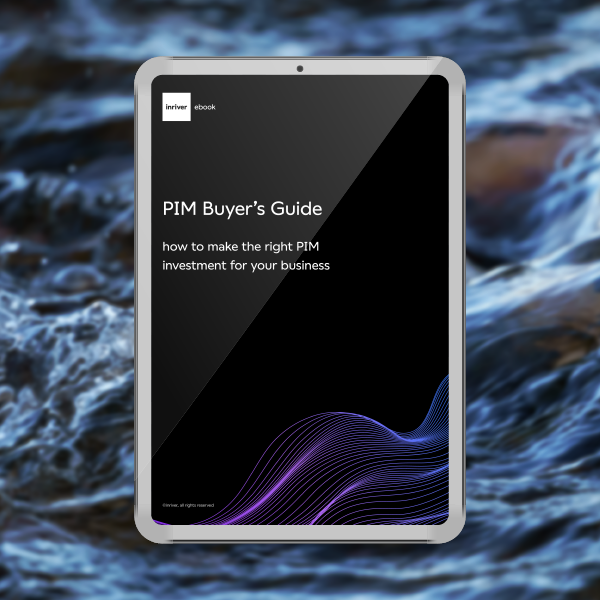PIM for retail
ace digital and in-store sales with PIM
By integrating Product Information Management software into their tech stack, it’s game, set, and match for forward-thinking retailers looking to maximize in-store and digital sales.
In an increasingly competitive retail marketplace, the need for retailers to provide exceptional product experiences and buyer journeys has never been stronger. A compelling shopping experience is key to winning new customers and maintaining the satisfaction of existing customers in all markets and across all channels.
However, providing these winning experiences across an increasingly omnichannel sales environment can be challenging. This is particularly true for retailers who do not have a solid handle on their product data across all internal and external-facing channels.
That’s why so many retailers are turning to the power of Product Information Management (PIM) software. An advanced PIM platform supports even the most complex omnichannel strategy and delivers winning product experiences and personalized buyer journeys at every endpoint. Here’s how.
- What is a PIM system?
- Benefits of PIM for retailers
- Key PIM features for retailers
- Omnichannel retail with a PIM solution
- How PIM improves the in-store retail experience
- The product journey in retail
- Integration with e-commerce platforms
- Why is PIM important for retailers?
- Choosing the right PIM solution for retail
What is a PIM system?
A PIM solution is a centralized hub for all product data for both internal and external channels. An advanced PIM system ensures accurate, up-to-date, and consistent data flows throughout the value chain. By onboarding raw data into their PIM platform, retailers can transform it into complete, compelling, and compliant product information that can then be distributed across all digital channels and physical in-store locations.
Benefits of PIM for retailers
Today’s digital age demands product information that is accurate, accessible, and consistent across all platforms. This is especially true for retailers weathering the storm of rapid e-commerce evolutions such as the rise of social media as a buying platform and ever-changing consumer preferences.
Advanced PIM architecture offers a suite of benefits that can transform the way retailers manage and utilize their product data—streamlining internal processes for enhanced customer experience and, ultimately, contributing to increased sales and market growth.
Here are some of the many benefits:
- Single source of truth: Acting like the central nervous system for a retailer, PIM uses the constant flow of product data to connect disparate processes—from supplier onboarding to in-store displays—to provide complete upstream-downstream connectivity.
- Internal efficiencies: By automating workflows, PIM reduces manual efforts around data management. This reduces the risk of human error, improves time to market, and frees up team members to focus on strategic tasks.
- Regulatory compliance: With a single source of truth, PIM enables retailers to rapidly update product content and information in adherence with the latest compliance issues, whether for a new market, new regulation, or new channel.

- Omnichannel agility: PIM can accelerate a retailer’s online expansion into multiple marketplaces, social channels, and physical locations by enriching and syndicating product data seamlessly.
- Enhanced cross-sell and upsell opportunities: By supporting the limitless creation of data-driven relationships between products, parts, components, and attributes through an extensible data model, PIM supports successful after-sales strategies.
- Contextualized customer experiences: PIM can tailor product information and catalogs for retail channels—emphasizing preferred features and bundles for microsegments and localizing content for different audiences.
- Omnichannel buyer journeys: A PIM helps deliver consistent product experiences across channels and devices to reinforce brand experience through the entire buyer’s journey.
- Better in-store experiences: PIM enhances the in-store experience from the ground up—from accurate product inventory management and pricing management to accessible compliance data and self-service buyer journeys fueled by accurate information.
The benefits of PIM for retail are far-reaching, impacting everything from operational efficiency to customer satisfaction and engagement. By adopting a robust PIM system, retailers can streamline their retail product information management and create a more dynamic, proactive retail environment.
Key PIM features for retailers
PIM retail solutions are pivotal in the dynamic e-commerce environment to stay ahead. Through the comprehensive management of product content and information, retailers can create product experiences and buyer journeys that maximize the value of their product information.
The key features of an advanced PIM system built for retail include:
- Supplier onboarding portals: PIM solutions accelerate supplier data onboarding to streamline this crucial first mile of a product’s journey from sourcing and design to marketing and sales. This enables retailers to swiftly introduce new products, maintain accurate product information, and enhance collaboration with suppliers.
- Digital Asset Management (DAM): PIM systems with DAM capabilities built in can elevate product experiences by centralizing the management of all product-related assets, including images, technical drawings, regulatory documentation, and more. These assets can turn good product listings into rich, compelling product stories that shift the buying needle.

- Product Data Syndication (PDS): With Product Data Syndication, PIM implementations offer a seamless path for data quality from product information to product experience. This is vital for retailers to maintain brand and product consistency across multiple marketplaces, automate otherwise manual efforts, and accelerate time-to-market.
- Digital Shelf Analytics (DSA): PIM retail solutions that integrate Digital Shelf Analytics capabilities provide near-real-time data insights into how your products perform online. This digital shelf monitoring is crucial to ensure all digital product listings remain optimized for conversions.
By investing in an enterprise-grade PIM system that encompasses these PIM features and capabilities, retailers can gain a significant competitive advantage, marked by personalized, consistent brand experiences that resonate with today’s consumers.
Omnichannel retail with a PIM solution
In omnichannel retail, customers engage with branded experiences across many touchpoints including mobile apps, online stores, physical showrooms, marketplaces, social channels, and more. Presenting a unified brand identity across these touchpoints is critical—and doing so requires keeping product data synchronized.
PIM software serves as the vehicle for omnichannel execution by streaming reliable product information out to all channels while collecting back channel-specific customer analytics. A PIM’s flexible syndication tools power the entire circular ecosystem.
How PIM improves the in-store retail experience
Even as retail shifts online, brick-and-mortar stores remain vital for showcasing products and nurturing customers. If an in-store experience doesn’t live up to a customer’s expectation, it can mean losing their trust for good.
In terms of stock availability, PIM ensures shelves remain stocked with the right products, eliminating under or over-stocking. Digital displays dynamically update to match availability. In-store marketing efforts can also match online channels by centralizing the data management behind the scenes.
With a PIM at the core of your product information, you never have to question whether the product information online and your in-store experience match—they’ll be in lock-step.
The product journey in retail
In a departure from the “make-use-dispose” model of the past decades and even centuries, retailers today are growing aware of the need to build circularity into their products. This is driven by evolving consumer expectations surrounding sustainability, regulatory demands for transparency, and retailers themselves seeking greener products and processes.
The transition to a more circular business model, through the re-imagination of product journeys, is a key aspect of this shift towards traceability and sustainability. An advanced PIM system supports this shift by enabling retailers to effectively manage product data at every stage of the circular product journey:
- Source + Design
- Make
- Take to Market
- Sell
- Use + Reuse
- Repair + Retire + Recycle
For more information on the circular product journey, and how PIM powers the transition towards circularity for retailers across all sectors and industries, read the complete inriver guide.

Integration with e-commerce platforms
While a modern storefront, flexible CMS, and reliable infrastructure provide a strong foundation for retail businesses, the lynchpin for success online and in-store is a PIM system. Understanding the differences between PIM and CMS is crucial for leveraging both to their fullest potential.
With advanced connectors and APIs, retailers can propagate enriched product data directly from PIM into front-end e-commerce databases and store themes in real-time. This eliminates reliance on manual duplication across disconnected systems which inevitably drifts into inconsistencies. Instead, teams simply manage data from a unified PIM—and better customer experiences flow outward.
The impact on customers is immediate—visually consistent, complete, and compelling product pages that build credibility and conversions. And internally, PIM integration reduces your tech stack, breaks down data silos, and unlocks more of your team’s bandwidth.
Why is PIM important for retailers?
Succeeding in retail today is a high-demand, on-demand job. Retailers must juggle marketplace requirements, regulations, and consumer demands. This juggling act can quickly lead to data fragmentation. On average, a brand’s analytical process involves:
- 6 data sources
- 40 million rows of data
- 7 different outputs
This fragmentation can easily debilitate retailers through disjointed visibility, wasted resources, and broken customer trust.
By consolidating product data into a connected hub, PIM solutions transform retailers into agile enterprises. This centralization ensures synchronized data, streamlined workflows, better consumer experiences, and a more powerful omnichannel presence.

Choosing the right PIM solution for retail
For retailers seeking a PIM solution, the ideal platform stands apart in its ability to deliver complete omnichannel agility. And can support digital transformation from basic syndication into flexible, customizable, and circular solutions.
The right PIM system for retailers should:
- Equip retailers with data-driven insights and customer intelligence to inform personalized buying experiences.
- Offer intuitive role-based interfaces, allowing merchandisers of all technical proficiency levels to access assortment performance, inventory gaps, and buyer behaviors while still benefiting from smart data quality guidance.
- Provide flexible data models to handle seamless data sharing across ecosystems without fragmentation, preferably through a cloud-based PIM platform.
With an advanced PIM solution for retail in place, retailers can streamline their product information management and simultaneously enhance customer experiences, paving the way to business transformation and growth.
inriver: The complete PIM for retail
With complex omnichannel sales strategies, heightened customer expectations, and increased requirements from channels and regulators alike, the challenges facing retailers are clear. That’s why so many global retailers are turning to Product Information Management software from inriver to help them use product data to meet the needs of today and exceed the expectations of tomorrow.
The multi-tenant inriver PIM solution offers complete product software for retailers, transforming raw value chain data into rich, meaningful, and engaging product information for the right audience, on the right channel, at the right time. With API-based syndication and digital shelf analytics integrated into the inriver platform, retailers can build a brighter future for their customers, their products, and their profit margins, only possible with inriver.
want to see the inriver PIM in action?
Schedule a personalized, guided demo with an inriver expert today to see how the inriver PIM can get more value from your product information.
